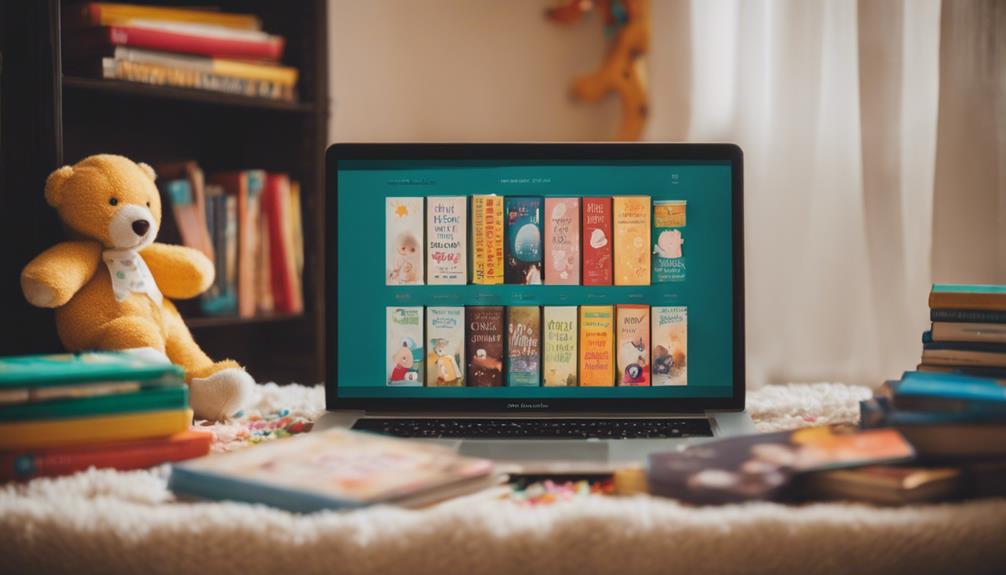Boost your child’s early literacy with top baby reading books specifically designed for development. Check out high-contrast visual stimulation books for infants, which encourage engagement. Help your child develop imitation and emotional intelligence with face feature books that enhance social and communication skills. Choose interactive learning books with sturdy construction and tactile elements to improve fine motor skills. Support language development with song books that introduce new words through repetitive lyrics. Create a calming bedtime routine with specific books that promote bonding and consistency. Explore parenting books that offer insights, practical tips, and understanding for academic readiness. These resources are essential for enriching your child’s literary journey.
Key Takeaways
- Visual Stimulation Books support early literacy with high-contrast patterns for newborns.
- Books Featuring Faces aid in emotional intelligence and social skills through facial recognition.
- Interactive Learning Books enhance fine motor skills and sensory exploration with tactile elements.
- Song Books foster language development and social interaction through repetitive lyrics.
- Bedtime Routine Books create a calming bedtime atmosphere and enhance bonding experiences.
High-Contrast Visual Stimulation Books
High-contrast visual stimulation books are essential for newborns and infants to develop their visual skills and exploration abilities. These books feature intriguing black and white patterns that are perfect for young eyes. The bold, contrasting images in high-contrast books provide the ideal visual stimulation for your little one. Not only are these books visually engaging, but they also play a vital role in supporting early literacy. By exposing babies to black and white shapes, these books help promote visual engagement, focus, and attention from an early age.
Early cognitive development, visual tracking, and attention are all nurtured through high-contrast visual stimulation books. The simple yet powerful design of these books enhances visual processing, cognitive abilities, and overall brain development in infants. Introducing your baby to these captivating images can set a strong foundation for their future reading and learning experiences.
Books Featuring Faces for Imitation

Books featuring faces for imitation are beneficial for babies as they help in recognizing and mimicking facial expressions. These books aid in developing social skills and promoting visual processing as infants focus on different facial features.
Engaging with faces in books can enhance emotional intelligence, language development, and early communication skills in babies.
Facial Expression Books
Featuring close-up images of various emotions, facial expression books are designed to help babies recognize and imitate different facial expressions. These books showcase a range of feelings like happiness, surprise, sadness, and more, engaging babies in understanding and mimicking emotions.
By focusing on facial expressions, babies can enhance their visual processing skills and emotional comprehension. The emphasis on faces in these books also aids babies in imitating expressions, fostering improved social interaction and communication abilities.
Introducing babies to facial expression books early on can support their cognitive development and emotional intelligence, laying a strong foundation for future learning and social interactions. These books provide a fun and interactive way for babies to explore and learn about emotions, helping them develop essential skills for understanding and expressing feelings as they grow.
Mimicry and Learning
Engage your baby's curiosity and foster early social development by introducing them to interactive books that showcase faces for imitation.
- Facial Expressions: Books featuring faces encourage babies to imitate various facial expressions, aiding in the development of early literacy skills.
- Natural Attraction: Infants are naturally drawn to faces, making face-centric books engaging and stimulating for visual processing.
- Emotional Recognition: Imitating facial expressions from books helps babies learn to recognize emotions, promoting social and emotional development.
- Cognitive Development: Visual engagement with faces in books supports cognitive development, enhancing early literacy skills and fostering a sense of connection and interaction.
Reading books with faces not only provides a fun and interactive experience for babies but also plays an essential role in their overall development, from recognizing emotions to building essential social skills.
Sturdy Interactive Learning Books
Sturdy interactive learning books are built to withstand the rough handling of curious babies. These durable books feature engaging tactile elements like flaps, textures, and buttons that enhance sensory exploration.
They provide a safe and educational way for infants to develop early literacy skills and fine motor abilities.
Durable Interactive Design
Crafted with sturdy materials, interactive learning books for babies guarantee lasting durability for extended play and exploration. These durable interactive design books not only withstand rough handling but also offer engaging experiences that aid in early literacy skills development.
Here are some key points to ponder about these books:
- Essential Quality: Sturdy materials ensure these books can endure the wear and tear of enthusiastic little hands.
- Interactive Features: From flaps to textures, these books incorporate elements that captivate babies and enhance sensory learning.
- Safe Exploration: The robust design of these books allows infants to freely interact with the content without safety concerns.
- Skill Development: Interactive learning books play a vital role in fostering fine motor skills, hand-eye coordination, and cognitive abilities through hands-on engagement.
Investing in durable interactive design books can provide a foundation for your child's early literacy journey while offering a safe and engaging learning experience.
Engaging Tactile Features
Designed with a variety of tactile elements, sturdy interactive learning books offer engaging sensory experiences for babies. These interactive learning books feature textures, flaps, and moving parts that entice babies to explore and interact with the pages.
By engaging in sensory exploration, babies develop fine motor skills, hand-eye coordination, and cognitive abilities. The interactive features in these sturdy books encourage active participation, sparking curiosity and fostering early literacy skills.
Babies delight in touching and feeling different textures, colors, and shapes within the pages, enhancing their sensory experiences and cognitive development. Additionally, the durability and safety of these interactive learning books make them ideal for independent exploration, allowing babies to handle the books confidently and cultivate a love for reading from a young age.
With sturdy interactive learning books, babies can begin a tactile adventure that stimulates their senses and nurtures a lifelong passion for books.
Song Books for Language Development

Engage your baby in language development through rhymes, rhythms, and repetition by reading song books together. Song books offer a delightful way to enhance your little one's early literacy skills while providing an enjoyable bonding experience. Here are some reasons why song books are beneficial for language development:
- Improved Listening Skills: Song books captivate babies with melodic patterns, helping them tune in and focus on sounds.
- Enhanced Vocabulary: The repetitive lyrics in song books introduce new words in a memorable context, expanding your baby's language repertoire.
- Social Interaction: Familiar tunes in song books encourage babies to participate, fostering communication and interaction between you and your child.
- Memory Retention: The predictable nature of songs aids in memory recall, supporting cognitive development in infants.
Incorporating song books into your daily routine can create a positive association with reading and music, laying a strong foundation for your baby's language skills.
Nighttime Bedtime Routine Books

To help your child wind down and prepare for sleep, consider introducing nighttime bedtime routine books into your evening reading regimen. These bedtime routine books are specifically designed to create a calming and soothing atmosphere, perfect for signaling that it's time to rest. Featuring gentle rhymes, soft illustrations, and comforting messages, bedtime stories can help promote relaxation and prepare your little one for a peaceful night's sleep. Engaging with these books not only aids in establishing a consistent bedtime routine but also enhances the bonding experience between you and your child during this special time of day.
| Top Nighttime Bedtime Routine Books | Age Range |
|---|---|
| "Goodnight Moon" by Margaret Wise Brown | 0-3 years |
| "The Going-To-Bed Book" by Sandra Boynton | 1-4 years |
| "Time for Bed" by Mem Fox | 1-5 years |
| "Guess How Much I Love You" by Sam McBratney | 1-6 years |
| "On the Night You Were Born" by Nancy Tillman | 2-7 years |
Parenting Books for Early Literacy

Exploring parenting books for early literacy equips you with essential knowledge and practical strategies to enhance your child's reading skills right from the start. These books are valuable resources that can guide you in creating a literacy-rich environment at home and engaging your child in meaningful reading activities.
Here are four key benefits of utilizing parenting books for early literacy:
- Insights and Strategies: Gain valuable insights and effective strategies on how to support your child's reading development at a young age.
- Practical Tips: Get practical tips on reading aloud, selecting age-appropriate books, and instilling a love for reading in your child.
- Understanding Reading Development: Learn about the different stages of reading development and how to effectively nurture your child's literacy journey.
- Preparation for Academic Success: By implementing advice from these books, you can play an important role in preparing your child for academic success through enhanced early literacy skills.
Frequently Asked Questions
How Can We Encourage Babies to Learn Literacy?
Encourage babies to learn literacy through interactive reading. Use high-contrast books for visual stimulation, books with faces for engagement, and sturdy books for safe exploration. Sing songs from books to develop language skills and bond emotionally while supporting overall development.
What Should I Start Reading to My Baby?
Start with high-contrast black and white books to stimulate visual skills, then introduce books with faces showing baby expressions for engagement. Opt for sturdy, drool-proof options for safe exploration, and include song books for developing listening skills and vocabulary.
What Age Should I Start Teaching My Baby to Read?
You should start teaching your baby to read around 6 months old. Reading to babies early helps develop language skills and build a strong foundation for literacy. Choose engaging books with high-contrast images and interactive features to capture their attention.
How Can I Teach My Baby to Read Early?
To teach your baby to read early, start with high-contrast books for visual stimulation. Use books with faces for engagement. Choose sturdy options for safe play. Incorporate book songs to enhance language skills. Reading is key for your baby's development.
Conclusion
To sum up, these top baby reading books are like a ray of sunshine in the world of early literacy. They provide a fun and engaging way for parents to bond with their little ones while laying the foundation for a lifelong love of reading.
So grab a book, snuggle up with your baby, and watch their imagination soar with these fantastic choices. Happy reading!










